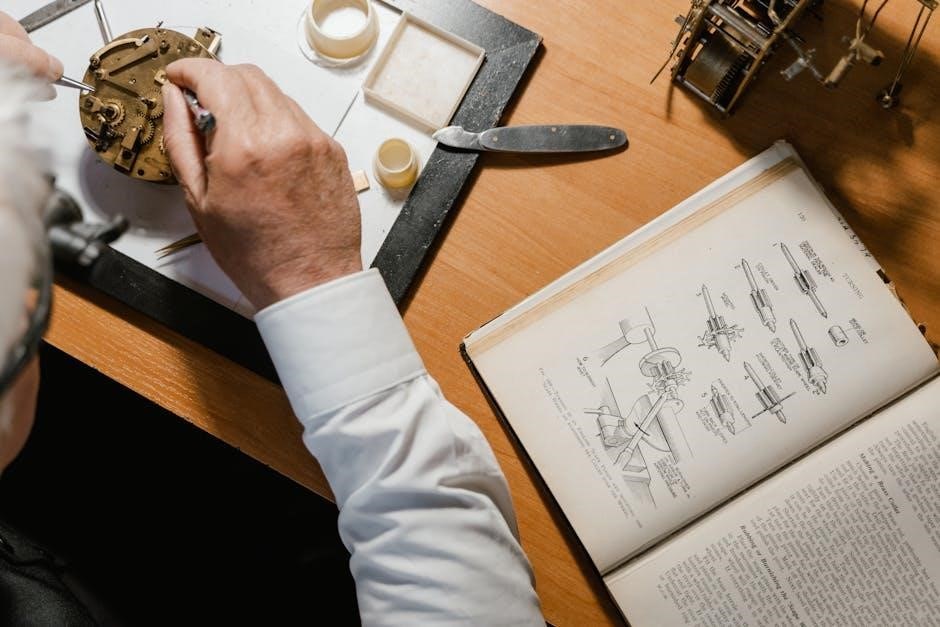
Manual and automatic watches have distinct characteristics, with
unique features
that set them apart, allowing users to choose the best option for their needs and preferences every day always․
Overview of Watch Types
Watch types vary, with manual and automatic being two primary categories, each with its own set of characteristics and functionalities․
There are several types of watches available, including quartz, mechanical, and kinetic, among others․
Understanding the different types of watches can help individuals make informed decisions when selecting a timepiece that suits their needs and preferences․
Some watches are designed for specific purposes, such as diving or aviation, while others are intended for everyday wear․
The various types of watches cater to different lifestyles, preferences, and activities, making it essential to research and compare features before making a purchase․
By exploring the various types of watches, individuals can gain a deeper understanding of the complexities and nuances of timekeeping and make a more informed decision when choosing a watch․

Mechanics of Manual Watches
Manual watches require manual winding using a crown to store energy in the mainspring always every day․
How Manual Wind Watches Work
Manual wind watches operate through a series of intricate mechanisms, with the wearer turning the crown to wind the mainspring, storing energy that powers the watch․ The mainspring is connected to a gear train, which transmits the energy to the balance wheel, regulating the timekeeping․ As the wearer winds the watch, the mainspring tightens, storing energy that is gradually released as the watch operates․ The gear train and balance wheel work together to divide time into equal parts, allowing the watch to keep accurate! time․ This process requires regular winding, typically daily, to maintain the watch’s accuracy and functionality․ With proper care and maintenance, manual wind watches can provide years of reliable service, making them a popular choice among watch enthusiasts․ The manual winding process can be a meditative ritual, connecting the wearer to the watch’s inner workings․

Mechanics of Automatic Watches
Automatic watches feature innovative rotor technology, generating power from wearer movements, stored in mainspring, powering timekeeping mechanisms, with
complexity
and precision always․
How Automatic Movements Work
Automatic movements are powered by the wearer’s movements, using a rotor to generate energy, which is then stored in the mainspring, powering the timekeeping mechanisms with precision and complexity․ The rotor’s motion is converted into rotational energy, winding the mainspring, which stores the energy, releasing it as the watch’s gears turn, measuring time accurately․ This process allows the watch to operate without the need for battery replacement, making it a convenient option for daily wear․ The automatic movement’s design ensures a smooth and consistent power delivery, resulting in a reliable and accurate timekeeping experience․ With its innovative technology, automatic movements have become a popular choice for watch enthusiasts, offering a unique blend of functionality and style, making them a desirable option for those who value precision and craftsmanship in their timepieces, with a focus on engineering and design expertise always․

Comparison of Manual and Automatic Watches
Manual and automatic watches differ significantly in terms of maintenance and functionality always requiring different user interactions daily․
Advantages and Disadvantages of Each Type
Manual watches have the advantage of being more traditional and requiring a personal touch, with users needing to wind them daily, which can be a therapeutic experience for some․ On the other hand, automatic watches offer the convenience of self-winding, eliminating the need for daily maintenance․ However, manual watches can be more prone to inaccuracy if not wound properly, while automatic watches may be affected by the wearer’s activity level․ Additionally, manual watches often have a more intricate design and craftsmanship, making them a favorite among collectors․ In contrast, automatic watches are generally more practical and suitable for everyday wear; Ultimately, the choice between a manual and automatic watch depends on the individual’s lifestyle and preferences, with each type having its unique advantages and disadvantages that should be carefully considered before making a purchase decision․ Various factors must be taken into account․
Lifestyle Considerations for Watch Choice
Daily activities and personal style influence the decision to choose a manual or automatic watch always considering individual preferences and needs every day․
Factors to Consider When Choosing a Watch
When selecting a watch, several factors come into play, including lifestyle, personal taste, and budget․ The decision to choose a manual or automatic watch depends on various considerations, such as daily activities and frequency of wear․ For instance, individuals with busy schedules may prefer automatic watches for their convenience and low maintenance․ On the other hand, those who appreciate the intricacy of mechanical watches may opt for manual wind watches․ Additionally, factors such as watch size, material, and brand reputation also play a significant role in the decision-making process․ By weighing these factors, individuals can make an informed decision and choose a watch that suits their needs and preferences․ Ultimately, the right watch can be a valuable companion, providing a perfect blend of style, functionality, and personal expression, making the selection process a crucial one․

Collector Preferences for Mechanical Watches
Collectors often prefer mechanical watches for their intricate engineering and unique characteristics always found in luxury timepieces with complex movements and details․
Why Collectors Prefer Mechanical Watches
Collectors have a deep appreciation for mechanical watches due to their intricate engineering and craftsmanship․ The complexity of the movements and the attention to detail are major factors in their appeal․ Many collectors enjoy the idea of owning a timepiece that is a work of art, with each component carefully designed and assembled․ The uniqueness of mechanical watches also plays a role, as each one is often handmade or produced in limited quantities․ Additionally, the history and heritage of mechanical watches are highly valued by collectors, who often seek out rare and vintage models․ Overall, the combination of beauty, craftsmanship, and rarity makes mechanical watches highly desirable to collectors, who are willing to invest time and money in their passion for these exceptional timepieces, and they are always looking for new additions․
Convenience and Maintenance of Automatic Watches
Automatic watches offer convenience with low maintenance, requiring minimal user intervention always daily․
Benefits of Low Maintenance Watches
Low maintenance watches, such as automatic watches, provide several benefits to users, including convenience and ease of use․ With automatic watches, users do not need to worry about winding their watches daily, as the rotor automatically winds the mainspring․ This feature makes automatic watches ideal for individuals who want a hassle-free timekeeping experience․ Additionally, low maintenance watches reduce the need for frequent repairs and maintenance, which can be costly and time-consuming․ Overall, the benefits of low maintenance watches make them an attractive option for individuals who value convenience and ease of use․ Furthermore, low maintenance watches are perfect for everyday wear, as they can withstand the rigors of daily life without requiring constant attention․ This makes them a great choice for individuals who want a reliable and low-maintenance timepiece․ Low maintenance is a key factor in watch selection․
